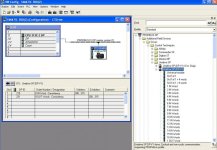DamianInRochester
Lifetime Supporting Member
I am using a Siemens CPU313C-2DP to communicate to a network of Control Techniques UnidriveSP drives by way of a SM-Profibus module (new installation -- all the latest firmware).
The network works fine. I have communication setup up with 8 cyclic in and 8 cyclic out.
I am having difficulty in figuring out how to utilize the DP-V1 non-cyclic parameter access. I am a bit confused as to how that needs to be setup (if at all) in the network config.
The manual talks about using the Profidrive channel and using the services to access the drive menu area, but it isn't clear to me what memory I access on the S7 end to accomplish this.
Any guidance would be much appreciated.

The network works fine. I have communication setup up with 8 cyclic in and 8 cyclic out.
I am having difficulty in figuring out how to utilize the DP-V1 non-cyclic parameter access. I am a bit confused as to how that needs to be setup (if at all) in the network config.
The manual talks about using the Profidrive channel and using the services to access the drive menu area, but it isn't clear to me what memory I access on the S7 end to accomplish this.
Any guidance would be much appreciated.




